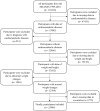Weight changes from early to middle adulthood and cardiometabolic multimorbidity later in life among middle-aged and older adults: a retrospective cohort study from the NHANES 1999-2018
- PMID: 38440787
- PMCID: PMC10910024
- DOI: 10.3389/fendo.2024.1306551
Weight changes from early to middle adulthood and cardiometabolic multimorbidity later in life among middle-aged and older adults: a retrospective cohort study from the NHANES 1999-2018
Abstract
Background: Weight gain in adulthood can influence the development of diabetes and cardiovascular diseases. It is speculated that weight gain is related to cardiometabolic multimorbility (CMM). This study was designed to examine the relationships between weight changes from early to middle adulthood and the risk of CMM.
Methods: Data of the National Health and Nutrition Examination Survey (NHANES) 1999-2018 cycles were analyzed in the present study. Weights at age 25 years and 10 years before recruitment were self-reported and were used to define five weight change patterns including stable normal, maximum overweight, obesity to non-obesity, non-obesity to obesity, and stable obesity patterns. Meanwhile, absolute weight changes were classified into five groups: weight loss≥ 2.5 kg, weight change within 2.5 kg, 2.5 kg≤ weight gain < 10.0 kg, 10.0 kg≤ weight gain < 20.0 kg, and weight gain≥ 20.0 kg. CMM was defined as the coexistence of two or three of diabetes, coronary heart disease (CHD), and stroke.
Results: A total of 25,994 participants were included. Across adulthood, compared to stable normal weight, maximal overweight, obesity to non-obesity, non-obesity to obesity, and stable obesity were consistently associated with increased risks of diabetes, CHD, and CMM. For instance, stable obesity was respectively related to 358.0% (HR: 4.58, 95% CI: 4.57, 4.58), 88.0% (HR: 1.88, 95% CI: 1.88, 1.88), and 292.0% (HR: 3.92, 95% CI: 3.91, 3.92) higher risks of diabetes, CHD, and CMM. Meanwhile, any account of weight loss and gain was linked to higher risks of diabetes, CHD, and CMM than weight change within 2.5 kg. However, participants with maximum overweight had a decreased incidence of stroke (HR: 0.85, 95% CI: 0.85, 0.86), and weight loss ≥ 2.5 kg and weight gain ≥ 2.5 and <20 kg were also related to a lower risk of stroke. J-shaped or U-shaped associations of absolute weight changes with the risks of diabetes, CHD, and CMM were observed.
Conclusions: Maintaining a stable normal weight can benefit more from the prevention of diabetes, CHD, and CMM. Both weight gain and loss across adulthood were accompanied by increased risks of diabetes, CHD, and CMM.
Keywords: body mass index; body weight changes; cardiometabolic diseases; cardiometabolic multimorbidity; obesity.
Copyright © 2024 Zhao, Zhao, Wang, Wang, Kong, Ma and Wang.
Conflict of interest statement
The authors declare that the research was conducted in the absence of any commercial or financial relationships that could be construed as a potential conflict of interest.
Figures




Similar articles
-
Association of body mass index with risk of cardiometabolic disease, multimorbidity and mortality: a multi-state analysis based on the Kailuan cohort.Endocrine. 2024 May;84(2):355-364. doi: 10.1007/s12020-023-03570-w. Epub 2023 Oct 25. Endocrine. 2024. PMID: 37878230
-
Gestational diabetes mellitus, body mass index, and cardiometabolic multimorbidity: A prospective cohort study.Ann Epidemiol. 2024 Nov;99:9-15. doi: 10.1016/j.annepidem.2024.09.002. Epub 2024 Sep 23. Ann Epidemiol. 2024. PMID: 39322091
-
Obesity, composite dietary antioxidant index, and their interactive association with the risk of cardiometabolic multimorbidity in the elderly from a large national survey.Lipids Health Dis. 2025 Apr 9;24(1):132. doi: 10.1186/s12944-025-02549-y. Lipids Health Dis. 2025. PMID: 40205470 Free PMC article.
-
Serum/plasma biomarkers and the progression of cardiometabolic multimorbidity: a systematic review and meta-analysis.Front Public Health. 2023 Nov 23;11:1280185. doi: 10.3389/fpubh.2023.1280185. eCollection 2023. Front Public Health. 2023. PMID: 38074721 Free PMC article.
-
Potato Intake and the Risk of Overweight/Obesity, Hypertension, Diabetes, and Cardiovascular Disease: A Systematic Review and Meta-analysis of Observational Studies.Nutr Rev. 2025 Mar 1;83(3):466-478. doi: 10.1093/nutrit/nuae159. Nutr Rev. 2025. PMID: 39527022
Cited by
-
Relationship between body mass index and cardiovascular metabolic multimorbidity: a systematic review and meta-analysis.Front Cardiovasc Med. 2025 Jun 17;12:1568348. doi: 10.3389/fcvm.2025.1568348. eCollection 2025. Front Cardiovasc Med. 2025. PMID: 40599621 Free PMC article.
-
Constructing a Predictive Model to Evaluate the Risk of CHD Based on New Metabolic Indicators.Vasc Health Risk Manag. 2025 May 8;21:371-382. doi: 10.2147/VHRM.S521822. eCollection 2025. Vasc Health Risk Manag. 2025. PMID: 40357452 Free PMC article.
-
Weight change across adulthood in relation to the risk of COPD.Environ Health Prev Med. 2025;30:64. doi: 10.1265/ehpm.25-00059. Environ Health Prev Med. 2025. PMID: 40790505 Free PMC article.
References
-
- Hales CM, Carroll MD, Fryar CD, Ogden CL. Prevalence of obesity and severe obesity among adults: United States, 2017-2018. NCHS Data Brief (2020) 360):1–8. - PubMed
MeSH terms
LinkOut - more resources
Full Text Sources
Medical

